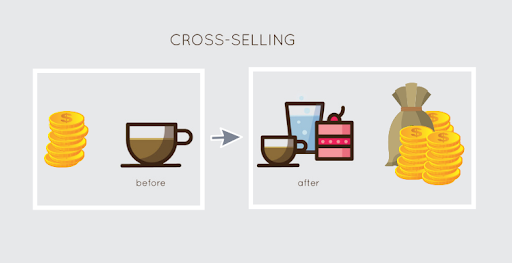Efficient cross-selling skill for salesman
Cross-selling is a term that is frequently used in lecture halls and by businesses in business strategies to increase sales performance. Follow along today to learn how this concept can help your business and how to use it in your sales tactics.
Table of Content
1. What is cross-selling?

Cross-selling is a business concept used by many well-known brands in their marketing and sales strategies. Customers will be introduced to more related products that help increase the experience and are frequently sold in the form of “combo” in addition to the brand’s main product or service.
Cross-selling products and services is a skill that is widely used in the FMCG industry by brands such as KFC, Lotte, McDonald’s, and others. When you purchase fried chicken, the staff will offer you additional water, chips, or suggestions. provide you with a “combo” package at a lower cost
Businesses can easily stimulate the “bargain” of customers to sell more products and services using this strategy.
2. What are the benefits of cross-selling?

Over the years, there is no business that can deny the benefits that cross-selling skills bring.
- Contributing to the growth of sales and profits
Revenue and profit are the “lifeblood” of the business and the primary goal. Cross-selling influences customer purchasing behavior and generates significant revenue. Furthermore, using cross-selling tactics will lower marketing costs while increasing sales effectiveness.
- Gain customer loyalty
Cross-selling skills include not only selling but also understanding customer psychology and purchase cohesion. That is, when employees introduce a cheaper bundle of products or services, customers notice and become loyal customers over time.
- Increase return on investment (ROI)
Businesses will not need to invest much to acquire new customers at high costs thanks to cross-selling. Existing customers will purchase more goods and services, resulting in increased revenue.
- Effective customer retention strategy
Customers will not look to competitors to use similar goods and services if the business provides goods that are more or sufficient for their needs. Cross-selling will keep them with the company for the long term and will continue to support it in the future.
3. The art of successful cross-selling
It is not too difficult for you to apply Cross-selling tactics to your business, namely:
- Suggested by-products:
You can imagine this when customers buy the main product, you can give suggestions to buy more related products. For example, if a customer buys laundry soap, you can introduce a laundry softener of the same brand. This tactic is also used on e-commerce platforms such as Tiki, Lazada, etc.
- Create savings combos:
Customer psychology dictates that they want to buy the most profitable products, and you should accommodate them by creating combos of main products and complementary products at lower prices than usual. This encourages customers to make additional purchases.
- Incentives:
Allow customers to shop with coupons or an attractive percentage discount. Customers must purchase at the permitted level in order to take advantage of the offer.
- Free delivery:
Customers have a general attitude that they do not want to pay additional fees outside of the purchase price, particularly the shipping fee. As a result, you can offer a “free shipping” program to entice customers to make a purchase.
When customers’ purchasing interests are prioritized with appealing programs and offers, their purchase intention rises. However, in order to employ successful cross-selling strategies, you must first understand the following principles:
- Communication with customers:
Businesses must actively communicate with customers in order to understand their needs and preferences in order to develop an effective cross-selling strategy.
- Track the customer journey:
When businesses track the customer’s purchasing journey, their cross-selling strategy becomes more secure. As a result, you’ll know when to launch a promotional sales strategy or introduce companion products.
- Flexibility in sales:
Instead of trying to force customers to buy, offer solutions that match their true needs, and introduce accompanying products that can help customers solve their problems more thoroughly. Customers will thus be willing to “pocket their wallets” in order to own the company’s products and services.
Hopefully, this article has helped you understand the fundamental concept of cross-selling and how to apply it to your business. Please continue to follow BEMO for the latest in business, management news and necessary skills.














